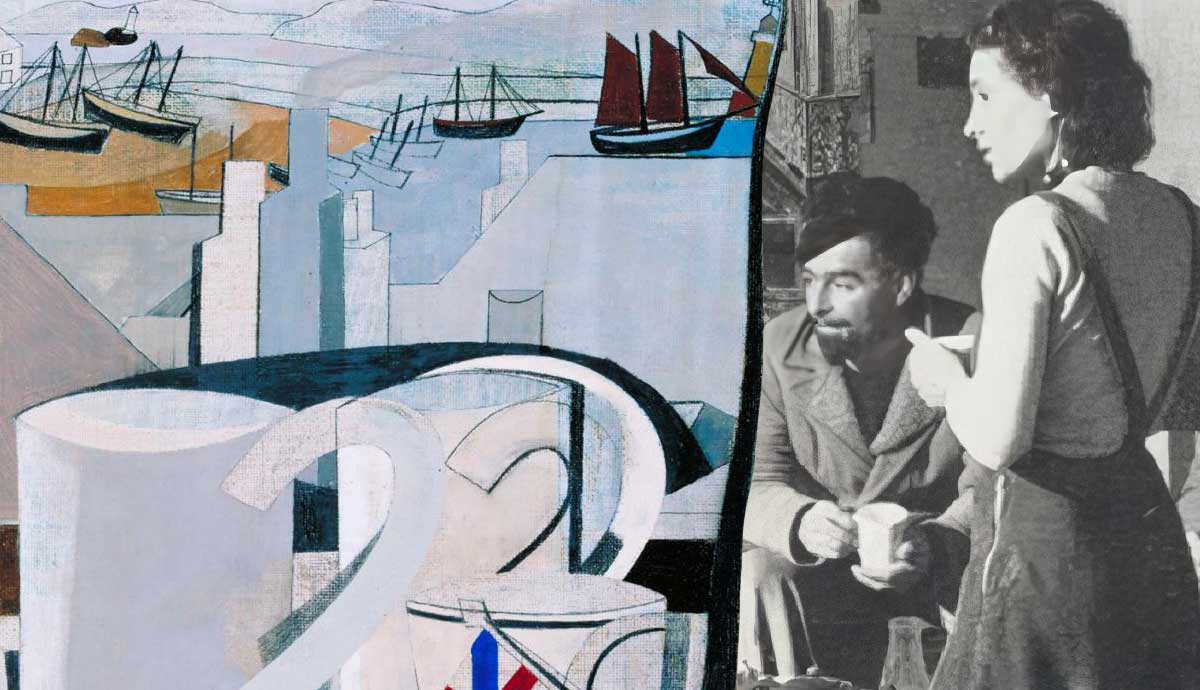
The St Ives School is a postwar British art movement of the mid-20th century, named after the fishing village of St Ives in Cornwall. Many artists congregated here during and after World War II to escape the war-time bombings of larger cities, and fell in love with the area’s rugged, un-spoilt coastlines, vivid colors and natural phenomena. As such, it became an important mecca where significant breakthroughs in abstraction were made throughout the 1940s to the 1960s. Artists in the St Ives School include Barbara Hepworth, Ben Nicholson, Christopher Wood, Alfred Wallis, Naum Gabo, Wilhelmina Barns-Graham, Sir Terry Frost, Peter Lanyon, Bryan Wynter, Patrick Heron, Paul Feiler and Bernard Leach.
Artists Congregated in St Ives During World War II

As early as 1928, the renowned British artist Ben Nicholson had made a visit to St Ives with his friend, the artist Christopher Wood. While there, they admired the bold simplicity of local painter Alfred Wallis’s art, and were entranced by the area’s natural coastlines. Meanwhile the renowned potter Bernard Leach had already established a studio in St Ives during the 1920s. All this meant that before the war St Ives had already become a popular site for creative voices.

In 1939, at the outbreak of war, Nicholson and his wife, the highly respected British sculptor Barbara Hepworth both moved to St Ives from London to escape London’s air raids. Here they found a suitable retreat from the industrial grit of London, and the wonder of the Cornish scenery made its way into their art. Other artists who joined them included the Russian constructivist Naum Gabo, Margaret Mellis and Adrian Stokes.
Many St Ives School Artists Merged Landscape with Abstraction

While living in London before the outbreak of war, both Hepworth and Nicholson had visited Europe and picked up on the latest trends for bold, geometric abstraction through artists including Piet Mondrian, Jean Arp, Constantin Brancusi, Georges Braque and Pablo Picasso. They brought these radical ideas to St Ives. Eventually, as the St Ives community of artists grew, a distinct brand of abstraction emerged from the artists who were living and working here, one that merged the latest European abstraction with references to the land, sea, sky and other natural phenomena of Cornwall.

The art critic and curator David Lewis later recalled, “…the landscape was the common factor for all of us, a presence of perpetual power which in its transitoriness reminds us of our own.” We see this clearly in the smooth sculptural forms of Barbara Hepworth, who referenced the curvature of cliffs and caves, as well as the smooth, careworn patina of rocks and shells she would gather while combing the beaches every day.
There Were Two Generations of St Ives School Artists

The St Ives School is often divided roughly into two distinct phases – the early school led by Nicholson and Hepworth, followed by a later generation of artists who settled here and took inspiration from their elders. Members of the second school include Bryan Wynter, Roger Hilton, Peter Lanyon, Wilhelmina-Barns Graham, and Paul Feiler. Each of these artists in turn responded to the Cornish landscape, while adopting a radical new language of abstraction that placed them at the center of innovation in postwar British art.

For example, Barns-Graham made drawings and paintings featuring craggy cliffs and rocky forms recalling Cornwall’s dramatic outlooks with a crisp, expressive language, while Lanyon painted sweeping, expressionistic abstract paintings based on the abstracted aerial views of Cornwall that he witnessed while travelling overhead in his hang glider, and looking down from above.










